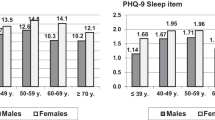Abstract
Insomnia is a major public health challenge. Due to its high prevalence and impact on health in recent years it has attracted attention of health care providers. The concept of quality of life (QOL) has gained importance as an outcome measure in sleep disturbed people. This study aims to determine the prevalence of insomnia among software engineers as the job related stress is considered very high. Ninety-one software engineers aged between 21 and 45 from a software developing company in Mysore formed the study population. Insomnia Screening Questionnaire and SF 36 Health Survey Questionnaire were used to elicit information about sleep quality and quality of life respectively. Sleep status among the subjects was as follows: 20.9% severe insomnia, 35.2% mild insomnia and 43.9% normal sleeper. Mean scores for SF 36 and those for physical and mental health were considerably lower among severe insomniacs. Software engineers run at the risk of developing insomnia, those with severe insomnia had poor QOL in comparison with the others. Quality of sleep among software engineers needs special attention since they are prone to develop sleep disturbances.

Similar content being viewed by others
References
Ancoli-Israel, S., & Roth, T. (1999). Characteristics of insomnia in the United States: results of the 1991 National Sleep Foundation Survey. Sleep, 22, 347–353.
Ayas, N., White, D., Manson, J., Stampfer, M., Speizer, F., Malhotra, A., et al. (2003). A prospective study of sleep duration and coronary heart disease in women. Archives of Internal Medicine, 163(2), 205.
Barry, P., Gallagher, P., & Ryan, C. (2008). Inappropriate prescribing in geriatric patients. Current Psychiatry Reports, 10(1), 37–43.
Ben-Bakr, K., Al-Shammari, I., & Jefri, O. (1995). Occupational stress in different organizations: a Saudi Arabian survey. Journal of Managerial Psychology, 10(5), 24–28.
Bixler, E., Kales, A., Soldatos, C., Kales, J., & Healey, S. (1979). Prevalence of sleep disorders in the Los Angeles metropolitan area. American Journal of Psychiatry, 136(10), 1257.
Brown, I. (1994). Driver fatigue. Human Factors: The Journal of the Human Factors and Ergonomics Society, 36(2), 298–314.
Chartier-Kastler, E., & Davidson, K. (2007). Evaluation of quality of life and quality of sleep in clinical practice. European Urology Supplements, 6(9), 576–584.
Chen, J.-C., Silverthorne, C., & Hung, J.-Y. (2006). Organization communication, job stress, organizational commitment, and job performance of accounting professionals in Taiwan and America. Leadership & Organization Development Journal, 27(4), 242–249.
Corfitsen, M. (1996). Enhanced tiredness among young impaired male nighttime drivers. Accident Analysis and Prevention, 28(2), 155. eknowledger.spaces.live.com.
Ferley, J., Balducci, F., Charrel, M., & Drucker, J. (1988). Frequence des troubles du sommeil et recours aux somniferes chez les habitants d’une ville moyenne. Identification de facteurs associés. Rev. Fr. Epidemiol., 41, 24–29.
Ganster, D. C., & Schaubroeck, J. (1991). Work Stress and Employee Health. Journal of Management, 17(2), 235–271.
Hatoum, H., Kong, S., Kania, C., Wong, J., & Mendelson, W. (1998). Insomnia, health-related quality of life and healthcare resource consumption: a study of managed-care organisation enrollees. Pharmacoeconomics, 14(6), 629–637.
Hohagen, F., Käppler, C., Schramm, E., Riemann, D., Weyerer, S., & Berger, M. (1994). Sleep onset insomnia, sleep maintaining insomnia and insomnia with early morning awakening—temporal stability of subtypes in a longitudinal study on general practice attenders. Sleep, 17(6), 551.
Hohagen, F., Rink, K., Käppler, C., Schramm, E., Riemann, D., Weyerer, S., et al. (1993). Prevalence and treatment of insomnia in general practice. European Archives of Psychiatry and Clinical Neuroscience, 242(6), 329–336. http://www.stress.org/job.htm.
Karacan, I., Thornby, J., Anch, M., Holzer, C., Warheit, G., Schwab, J., et al. (1976). Prevalence of sleep disturbance in a primarily urban Florida county. Social Science & Medicine, 10(5), 239–244.
Lawton, M. (1991). A multidimensional view of quality of life in frail elders. The concept and measurement of quality of life in the frail elderly, 4–27.
Leger, D., Scheuermaier, K., Philip, P., Paillard, M., & Guilleminault, C. (2001). SF-36: evaluation of quality of life in severe and mild insomniacs compared with good sleepers. Psychosomatic Medicine, 63(1), 49.
Lugaresi, E., Zucconi, M., & Bixler, E. (1987). Epidemiology of sleep disorders. Psychiatric Annals, 17, 446–453.
Mellinger, G., Balter, M., & Uhlenhuth, E. (1985). Insomnia and its treatment: prevalence and correlates. Archives of General Psychiatry, 42(3), 225–232.
Moline, M., & Zendell, S. (1993). Sleep education in professional training programs. Sleep Research, 22, 1.
Morin, C. M., LeBlanc, M., Daley, M., et al. (2006). Epidemiology of insomnia: prevalence, self-help treatments, consultations, and determinants of helpseeking behaviors. Sleep Medicine, 7, 123–130.
Nowell, P., & Buysse, D. (2001). Treatment of insomnia in patients with mood disorders. Depression and Anxiety, 14(1), 7–18.
Ohayon, M. (2002). Epidemiology of insomnia: what we know and what we still need to learn. Sleep Medicine Reviews, 6(2), 97–111.
Orr, W., Stahl, M., Dement, W., & Reddington, D. (1980). Physician education in sleep disorders. Academic Medicine, 55(4), 367.
Cheek, R. E., Shaver, J. L. F., & Lentz, M. J. (2004). Variations in sleep hygiene practices of women with and without insomnia. Research in Nursing & Health, 27, 225–236.
Sateia, M., Doghramji, K., Hauri, P., & Morin, C. (2000). Evaluation of chronic insomnia. An American Academy of Sleep Medicine review. Sleep, 23(2), 243.
Spiegel, K., Leproult, R., & Van Cauter, E. (1999). Impact of sleep debt on metabolic and endocrine function. The Lancet, 354(9188), 1435–1439.
Taylor, D., Lichstein, K., & Durrence, H. (2003). Insomnia as a health risk factor. Behavioral Sleep Medicine, 1(4), 227–247.
Thorpy, M., & Rochester, C. (1990). The international classification of sleep disorders: Diagnostic and coding manual. Rochester: American Sleep Disorders Association.
Weyerer, S., & Dilling, H. (1991). Prevalence and treatment of insomnia in the community: results from the Upper Bavarian Field Study. Sleep, 14(5), 392.
Zammit, G., Weiner, J., Damato, N., Sillup, G., & McMillan, C. (1999). Quality of life in people with insomnia. Sleep (New York, NY), 22, 379–385.
Author information
Authors and Affiliations
Corresponding author
Rights and permissions
About this article
Cite this article
Zadeh, S.S., Begum, K. Association Between Insomnia and Quality of Life: An Exploratory Study Among Software Engineers. Applied Research Quality Life 6, 335–347 (2011). https://doi.org/10.1007/s11482-010-9131-5
Received:
Accepted:
Published:
Issue Date:
DOI: https://doi.org/10.1007/s11482-010-9131-5



